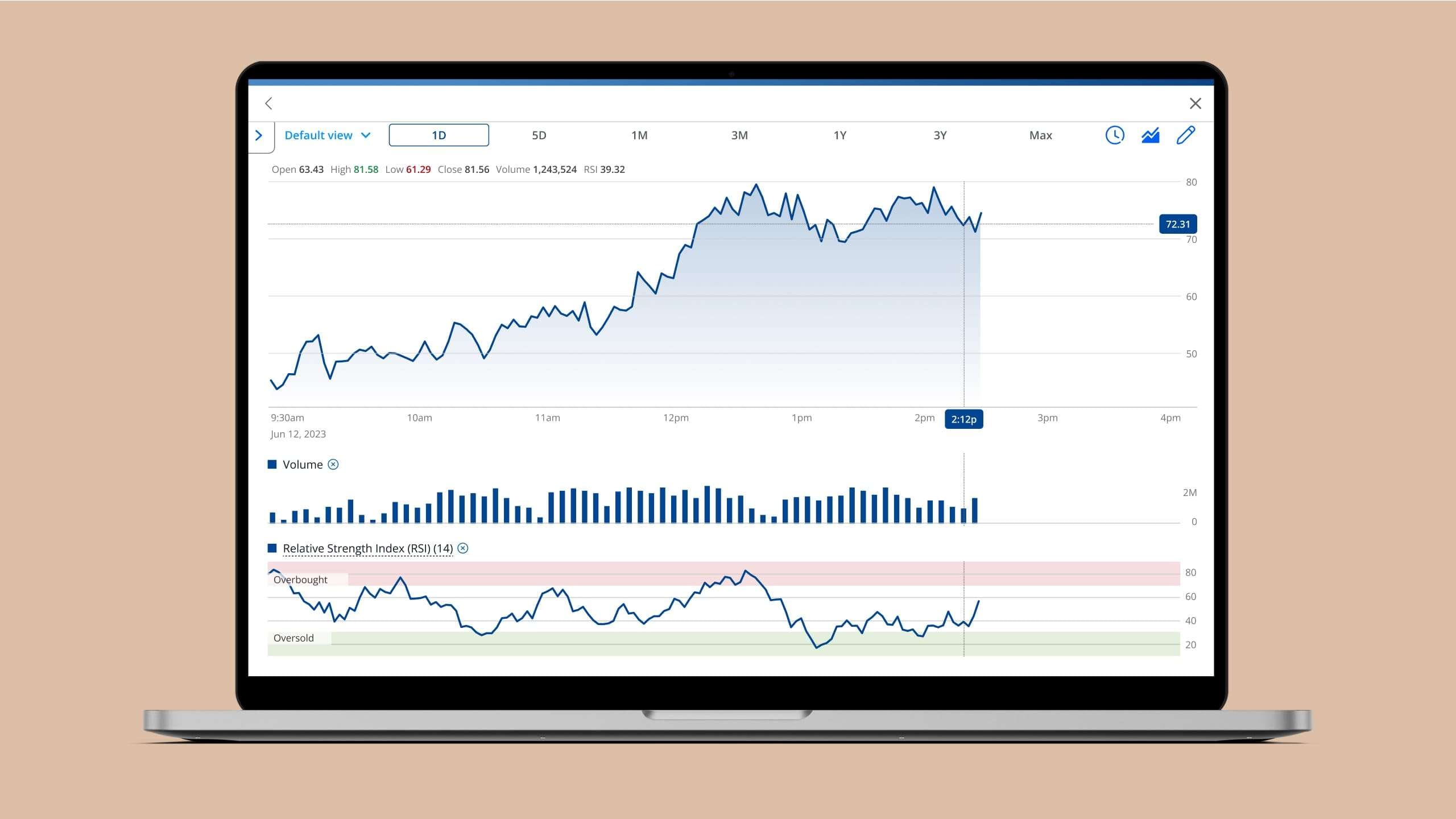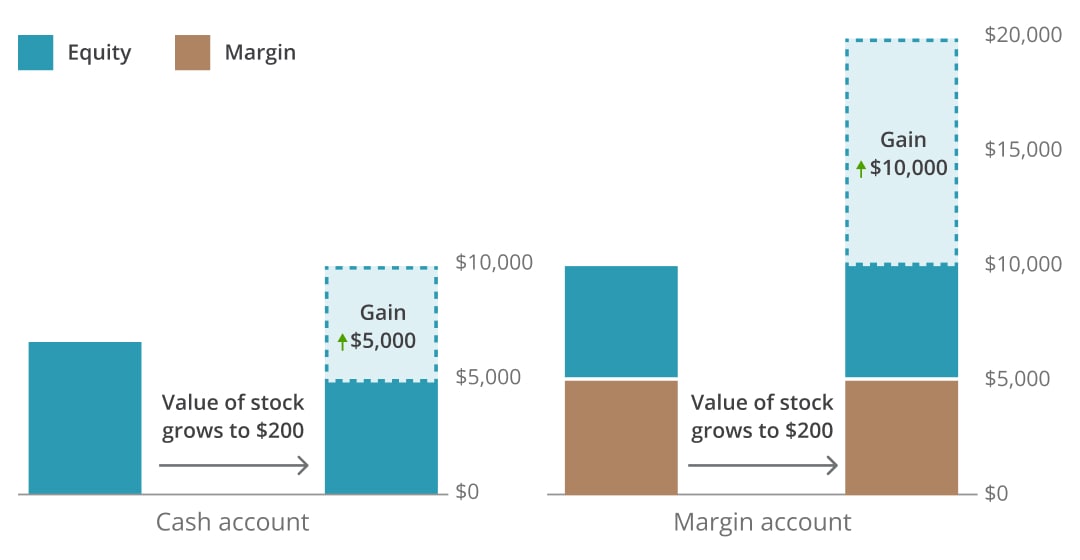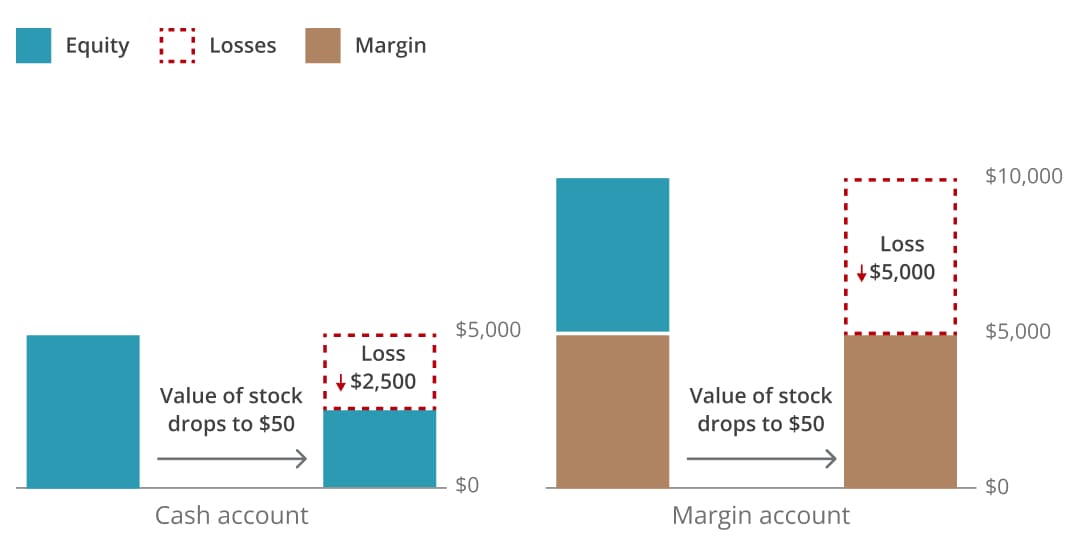Learn more about margin trading
What is margin trading?
Margin trading allows you to borrow money from J.P. Morgan Securities LLC (JPMS) to purchase more securities than you could using your own cash. Margin may not be available in all account types.
What are the risks of margin?
There are risks to using margin:
- While margin can amplify gains, it can also lead to quicker losses, which at times, can exceed your initial investment.
- J.P. Morgan Securities LLC can liquidate your securities, and/or increase house maintenance margin requirements without advance notice.
- Margin calls have a defined due date, however, we may liquidate your securities sooner depending on market conditions. Margin call extensions are not available.
- Interest on margin debt is charged regardless of investment performance, impacting overall returns.
See Margin risk disclosure for more details.
What else can you do with margin?
A margin loan could also be a convenient line of credit for non-investing short term financial needs without having to sell securities, such as real estate, home renovations or other large purchases, however this could create a margin call.
Margin trading with J.P. Morgan Self-Directed Investing
- Enjoy competitive margin interest rates and commission-free online trades.
- Use margin to trade and hold stocks, ETFs and options. A J.P. Morgan Self-Directed Investing margin account is not permitted to sell puts as a cash secured strategy.
- Conveniently transfer money between your Chase bank account and Self-Directed Investing account.
- Customer support with answers to your margin questions.

Margin trading rates and examples
It's important to understand fees, margin calls and potential risks before you begin.
The current prime rate can be found on the Federal Reserve website.
| DEBIT BALANCE | MARGIN RATE |
|---|---|
| $0 to $25,000 | PRIME + 4.75% |
| $25,001 to $50,000 | PRIME + 4.50% |
| $50,001 to $100,000 | PRIME + 4.00% |
| $100,001 to $500,000 | PRIME + 3.75% |
| $500,001 to $1,000,000 | PRIME + 3.00% |
| $1,000,001 to $3,000,000 | PRIME + 2.50% |
| $3,000,001 to $10,000,000 | SOFR + 2.35% |
| $10,000,001 and above | SOFR + 1.85% |
Frequently asked questions
Margin is the money borrowed from J.P. Morgan Securities LLC to purchase an investment. The existing securities in your account are used as collateral for the loan, but unlike a typical loan which has a set limit, this value can fluctuate as the value of your account changes. J.P. Morgan Securities LLC charges interest on the collateralized loan. Typically, margin allows an investor to leverage buying power up to two times what it would be without margin.
Margin trading allows clients to borrow money from J.P. Morgan Securities LLC to purchase more assets than they would be able to with their own funds. This is done by depositing a percentage of the asset's value. For instance, if a client deposits $5,000 into their margin account, they can buy up to $10,000 worth of securities. Gains and losses are both magnified with margin trading. The existing securities in the client's account serve as collateral for the loan, and the value of this collateral can fluctuate as the value of the account changes. Interest is charged by J.P. Morgan Securities LLC on the collateralized loan.
With a J.P. Morgan Self-Directed Investing margin account, you have the ability to trade and hold various financial products online, including stocks, ETFs, options, and fixed income. By borrowing against the value of the assets in your account, you can increase your buying power to purchase additional securities. A Self-Directed Investing margin account is not permitted to sell puts as a cash secured strategy.
A Reg- T Margin Loan
- Is governed by the Federal Reserve Board under Regulation T pursuant to the Securities Exchange Act of 1934
- Has FINRA as a Self-Regulatory Organization overseeing the maintenance of credit
- Is an extension of credit by J.P. Morgan Securities LLC using the securities and cash in your account as collateral
- Is typically used to purchase, carry or trade securities
- Can be used to purchase more eligible securities than you could with your own cash
- Can be used to create liquidity for clients who own fully paid for eligible margin securities
- Is subject to maintenance of sufficient and acceptable collateral
- Is a revolving line of credit
- Has no defined maturity date
- May be terminated at any time by J.P. Morgan Securities LLC without notice to the client
- Has no minimum or maximum lending amount, but this is subject to the posted collateral
- Requires that minimum equity levels to be satisfied when borrowing
When you navigate to our trade page and enter a security in your margin-enabled J.P. Morgan Self-Directed Investing account, the initial and maintenance requirement will be displayed. Lending Value is the inverse of the requirement (or "haircuts") charged on each security. Example: A 30% margin requirement equates to a 70% lending value for the security.
You must maintain a minimum equity requirement of $2,000 ($25,000 for pattern day traders) when borrowing. You must also accept the terms of the J.P. Morgan Self-Directed Investing Margin Agreement (including an acknowledgment that you have read and understood the Margin risk disclosure). Finally, you must meet eligibility requirements, including being of legal age. Before allowing margin trading, the firm may evaluate your creditworthiness and financial background.
Buying on margin occurs when an investor buys securities by borrowing the balance from J.P. Morgan Securities LLC. In order to buy on margin, you must have a margin account rather than a standard brokerage account. Each time you place a new trade, you must cover a percentage of the purchase price with cash or collateral. The percentage requirement is known as initial margin and the current initial margin requirement by the Federal Reserve Board’s Regulation T is 50%. This means investors can borrow no more than half of the purchase price.
For example: After depositing $5,000 into your margin account, you have purchasing power of up to $10,000 worth of marginable equity securities. If you buy $2,000 worth of stock, you still have $8,000 worth of buying power remaining. In this event, you haven’t utilized your margin yet because you only start borrowing money after you buy securities worth more than $5,000.
Margin lending is available for listed equities, ETFs, options, mutual funds and fixed income products. However, there may be holding periods before an asset is eligible for lending value. These securities act as collateral for the borrowed money, allowing clients to leverage their investments. The collateral must meet the firm’s margin maintenance standards, which may also have restrictions on securities or asset types. It is also important to remember that J.P. Morgan Securities LLC may impose limits on lending values at our sole discretion, and may change those limits at any time without notice to you.
Significant risks are involved when trading on margin. These include possible losses that are greater than your initial investment since borrowed money magnifies losses. You could have to make a deposit in response to a margin call. Rapid price fluctuations brought on by market volatility might result in large losses due to margin calls. The interest rate on this loan is variable.
- You can lose more funds than you deposit in the margin account. A decline in the value of securities that are purchased on margin may require you to provide additional funds to J.P. Morgan Securities LLC that has made the loan to avoid the forced sale of those securities or other securities or assets in your account(s).
- J.P. Morgan Securities LLC can force the sale of securities or other assets in your account(s). If the equity in your account falls below the maintenance requirements or the firm's higher "house" requirements, the firm can sell the securities or other assets in any of your accounts held at the firm to cover the margin deficiency. You also will be responsible for any short-fall in the account after such a sale.
- The firm can sell your securities or other assets without contacting you. Some investors mistakenly believe that a firm must contact them for a margin call to be valid, and that the firm cannot liquidate securities or other assets in their accounts to meet the call unless the firm has contacted them first. This is not the case. Most firms will attempt to notify their customers of margin calls, but they are not required to do so. However, even if a firm has contacted a customer and provided a specific date by which the customer may meet a margin call, the firm can still take necessary steps to protect its financial interests, including immediately selling the securities without notice to the customer. Read more about the risks associated with margin in the Margin risk disclosure.
You have to maintain sufficient equity to meet the firms maintenance requirements and satisfy margin calls promptly if they occur. It is important that you fully understand the risks involved in trading securities on margin. Before trading eligible securities (stocks, ETFs, options) in a margin account, you should carefully review the J.P.Morgan Self-Directed Investing Margin Agreement (PDF) provided by J.P. Morgan Securities LLC, which covers the parties’ rights including, but not limited to, the right to sell your securities or other assets as outlined below. Consult J.P. Morgan Securities LLC regarding any questions or concerns you may have regarding your margin accounts. See Margin risk disclosure
There are two primary categories of margin requirements:
- Initial Reg T—An initial margin requirement is the amount of funds required to satisfy a purchase of a security in a margin account when the trade is initially executed. The initial, or Reg T, margin requirement is currently 50% of the purchase price for all marginable equity securities. In addition, the firm requires customers to have a minimum margin account equity of $2,000 when placing orders on margin, or otherwise must pay for the purchase in full.
- Maintenance margin—The minimum amount of equity you need to hold after accessing margin is known as the maintenance margin. If your account equity drops below this threshold, you could have to make more deposits or sell assets to cover the maintenance margin, or J.P. Morgan Securities LLC might liquidate your securities.
In order to buy or hold securities on margin, you must have a certain amount of equity in your account to cover the purchase. Margin requirements are determined by various entities, including the Federal Reserve, FINRA and J.P. Morgan Securities LLC.
Every margin account requires you to maintain a minimum account equity, known as maintenance margin. If you do not maintain that equity, J.P. Morgan Securities LLC will require you to deposit more funds into the account or sell eligible securities to pay down your loan and bring your account equity back to the required level. This is known as a margin call. A margin call usually indicates that one or more of your positions has lost value. When a margin call occurs, you must choose whether to transfer in cash or marginable securities to the account or sell some of the securities in your account.
Although less common, a margin call can also be created when the client does not hold enough lending value in their account to cover the initial margin requirements on a new trade.
When using a cash account, you can only buy investments with the money that you have on hand. However, with margin trading, you can borrow funds from J.P. Morgan Securities LLC to increase your buying power. Although this can lead to greater profits, it also comes with the risk of increased losses as you are responsible for paying back the borrowed funds and interest. Learn about margin risks
The amount of money available for purchasing additional securities on top of your cash balance in a Self-Directed Investing margin account is known as buying power (and assumes the security being purchased is a marginable equity security with 30% house lending value (50% Reg T lending value). Your available buying power is your total buying power minus your committed to open orders, pending outgoing transfers and holds on deposit. J.P. Morgan Securities LLC may also further reduce your buying power for any amount of uncleared funds, pending outgoing money movements, open orders and other events at our discretion.
Day trading in a Self-Directed Investing margin account involves buying and selling financial instruments on the same trading day to benefit from sudden price changes. If you make 4 or more day trades that represent 6% or more of your trading activity within a 5-day period, your account will be classified as a pattern day trading account as per FINRA rules. A pattern day trading account must adhere to the following FINRA regulations.
- Maintain a minimum of $25,000 in your account at the close of each business day to continue purchasing securities
- Any withdrawals that will bring your account equity under $25,000 will be rejected
On chase.com, you can check your pattern day trading status by reviewing pattern day trading tab on your trading ticket. Go to Trade > select your margin account > click “See trading how-to’s and FAQs” > Pattern day trading.
In a Self-Directed Investing margin account, you can remove the pattern day trade (PDT) status from your account one time. To do so, Go to Trade > Select your margin account > click “See trading how-to’s and FAQs” > Pattern day trading. The “What can I do next?” section includes the “Remove PDT” button, and your request will be processed in 1 to 2 business days.
Investing a significant portion of your portfolio in a single asset or a group of common assets is known as a concentration. Relying heavily on one position can increase the risk of your investment. To mitigate this risk, J.P. Morgan Securities LLC applies certain concentration guidelines in a margin account which may limit the amount that you can borrow on a security or portfolio. When a security represents a large ratio of account holdings based on market value, liquidity, industry, or outstanding shares, certain risk factors may be magnified. To offset some of the increased risks associated with these holding(s), an additional fee may be applied to the standard requirement on the position(s) in your account.
When purchasing securities on margin, you will need to repay the borrowed amount along with accrued interest. Review the terms and conditions of the J.P. Morgan Self-Directed Investing Margin Agreement for more information about how interest is calculated by J.P. Morgan Securities LLC.
To view your Self-Directed Investing margin account interest rate details, go to Positions > Margin details > Month-to-date interest.
The dollar amount shown is how much pending interest has accrued for the month so far based on how much you've borrowed. We collect the interest you owe on the first of each month. The percentage shown is the interest rate based on how much you borrow, shown as an annualized amount. Interest rates change based on the amount borrowed throughout a month, so you may see a blended rate.
Sharpen your knowledge
Break it down: Margin and margin call

Margin is the money borrowed from a brokerage firm to purchase an investment. The existing securities in your account are used as collateral for the loan, but unlike a typical loan which has a set limit, this value can fluctuate as the value of your account changes.
Margin account rules for day traders

Investors should ensure that they have enough equity in their margin account to stay at or above exchange and regulatory minimums, with a cushion to accommodate adverse market movements so as to avoid a Reg T or exchange call as well as trading violations.
Margin requirement: What you need to know

Investors interested in trading on margin, or trading larger sums using funds borrowed from their broker, must be aware of margin requirements and balances. Learn more about them.


